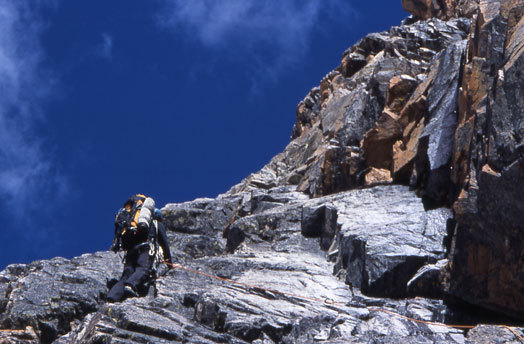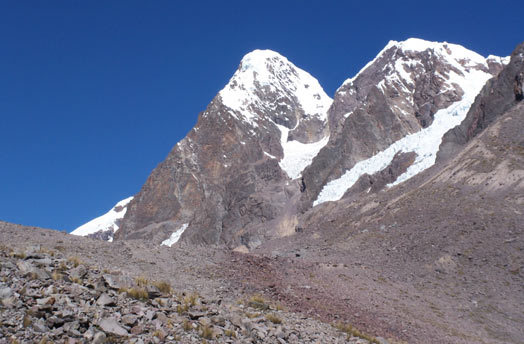
Mark Hesse on the first ascent of Satan’s Legs (VI 5.9 M5+ WI4 65 degrees, 1100m), east ridge, Nevado Callangate (aka Jatunriti, aka Chumpe, aka Cayangate: 6110m) in Peru’s Cordillera Vilcanota. Hesse, Chris Alstrin and Andrew Frost
opened the route in June in two and a half days. [Photo] Andrew Frost
With only rudimentary information about technical-route possibilities in Peru’s Cordillera Vilcanota, as Mark Hesse, Chris Alstrin and I made the three-day approach this summer, we grew increasingly excited. All around us appeared the potential for hard and varied alpine climbing. After establishing a base camp at 4500 meters, we selected Nevado Chumpe (6106m) as our first climb, though our approach through the talus and up the broken glacier was delayed while Mark fought the remnants of a virus. But on June 15, in the predawn dark, we crossed the remainder of the glacier to the base of our chosen route: the southeast face of the east ridge. The first 1,800 feet of climbing (all solo) was largely comprised of sixty to seventy-five-degree snow, with short sections of moderate vertical mixed and ice climbing.
We emerged on the east ridge in the still, early morning and roped up for the three more pitches of unconsolidated, granular, classic Peruvian snow climbing to the summit slopes. The runout slowed us, and we summitted just before noon into fabulous blue skies. With the exception of an eighty-foot rappel off an overhanging serac, the descent proceeded uneventfully, and we returned to our base camp the following day, feeling like Three Chumps on Chumpe (IV 75 degrees, 550m), and lounged around the waterfalls just downslope from our camp for a few full days of sun.
But when Mark had first introduced the idea of climbing in the Cordillera Vilcanota, one peak particularly captured all three of our imaginations: Colque Cruz I. And throughout our approach from Tinqui, its striking south face displayed a prominent and continuous ribbon of green waterice that tantalized us. But because of the recent, persistently clear conditions, that line had deteriorated into an active rockfall gully. We got over this disappointment by turning our focus instead to the beautiful 1100-meter east ridge of Nevado Cayangate (also seen on some maps as Nevado Jatunriti or Nevado Callangate: 6110m).
On the afternoon of the winter solstice, we walked up the glacier toward the base of the east ridge while clouds began to build in the north, enveloping the summits in vapor and the late gold light. As darkness lowered in, the temperature dropped abruptly, and when the alarm went off, clouds had begun rising toward us from the valley floor and descending from the ridge. In the waning moon, verglas shone on the rock. We went back to sleep. As the dawn arrived gray, we retreated to our base camp, and the hail rolled in with us.
The next three days delivered persistently poor weather. On the morning of June 24, we walked back up the glacier to the base of the route with only three days before the caballeros returned with their horses. Upon our arrival beneath the red granite ridge around 10 a.m., we began simul-climbing the initial 600 feet of 5.8 and 5.9 beneath a brilliant sky. Our joy continued into the early afternoon when high clouds closed together, and we entered a long section of mixed climbing that took us to our first bivy.
Although the next morning’s first pitch of the next morning had the poorest rock quality and protection, it also provided stellar exposure and sunlight, for which we were grateful after the long, cold night. After another six pitches of continuous 5.9 climbing we entered the snow high on Cayangate’s shoulder and began traversing up the east face as quickly as possible beneath the large, hanging seracs, sometimes climbing short waterice pitches in order to skirt crevasses and rockbands. The afternoon was a blur of white as the clouds descended again upon the snows and we struggled through them, until we summited in a whiteout around 5 p.m.
We descended to the col on the north side and bivied just below the pass. There we suffered a night of unrelenting winds and negative temperatures. It took almost the entire next day for the three of us to rappel the heavily crevassed glacier that flows down from the col and to make it through the additional 600 feet of rock rappels to the base of the ridge.
At dusk, June 26, we arrived back in camp to a warm meal and the smiles of Fortunato, our cook, and the caballeros. The next morning, we began our trek back to Tinqui. On the walk out, we named the route Satan’s Legs (VI 5.9 M5+ WI4 65 degrees, 1100m) because that powerful red granite ridge had reminded us of Virgil and Dante’s climb up Lucifer’s legs, out of Inferno and into the southern hemisphere, toward paradise.

Nevado Callangate (6110m) in Peru’s Cordillera Vilcanota. Satan’s Legs (VI 5.9 M5+ WI4 65 degrees, 1100m) takes the prominent (east) ridge. [Photo] Andrew Frost